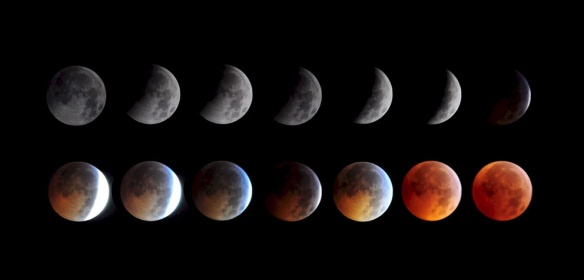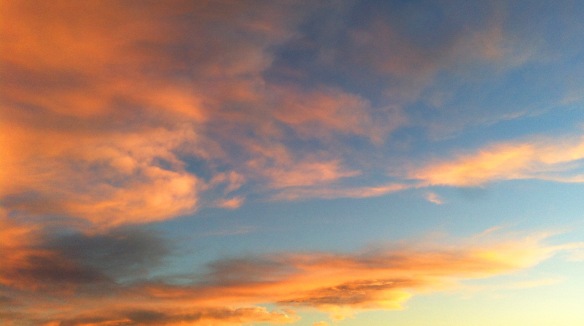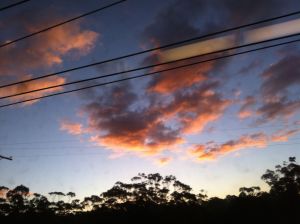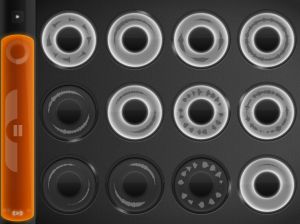In the interim from my last entry, a great deal has happened – the submission of of my honours research (which you can now read here), graduation from the B.Mus. at UWS, a university medal and now the commencement of a PhD, which is something I’d never dreamed of undertaking a few years ago. Really though, this all seems to be a continuation of a very long journey I’ve been pursuing, unconsciously sometimes, over many years. Trying to tie down this ‘in-between’ quality in music has actually led me back to where it all started in the first place, the nexus point where music and the visual seem to coalesce in this suspended state that I’m so fascinated with.
Although the main interest has always been with music and sound, I have a similar relationship to visual phenomena that appears to share the same ‘in-between’ quality, which I’ve documented in previous posts. Arnold Van Gennup, who first posited the idea of a liminal state in Rites de Passage (1908), noted that “the universe itself is governed by a periodicity which has repercussions on human life with stages of transition” (Van Gennep, 1960, p. 3). Although Van Gennup’s observations were based on human behaviour in rites of passage, it is the idea of liminality as a “nameless, spatio-temporally dislocated and socially unstructured” state (Thomassen, 2006, p. 322) that I believe has application for both music and imagery. Victor Turner expanded on Van Gennup’s ideas in the 1960s “to include both a personal and collective liminality, temporal as well as spatial” (Thomassen, p. 322) and in this respect Turner’s definition of liminality relates to both time and space. Van Gennup acknowledged that ritual often accompanied “celestial changes, such as the changeover from month to month (ceremonies of the full moon), from season to season (festivals related to solstices and equinoxes), and from year to year (New Years Day)” (Van Gennup, 1960, p.4) and it’s often in these transitional periods that I observe liminal occurences at play, i.e. the transition periods between day and night, namely twilight and dawn, when the quality of light and colour are changed so markedly from the pure tones of daylight. I seem to derive this sense of ‘in-between’ particularly in these periods, and use this quality in creating both my sense of a ‘liminal aesthetic’ in my work and attempting to bring about a ‘liminal state’ in the creative approach.
Phenomenological approaches to sound and vision
In my honours year research, I investigated what I believed to be liminality in popular music, especially music that sidestepped conventional notions of time. Looking at elements such as drone, repetition, metrical ambiguity and different forms of harmony all informed the practical component of the research. The examples I used were from my background in popular music, in particular 1960s pop and psychedelia, the ambient work of Brian Eno in the 1970s and the ‘shoegaze’ movement in the late 1980s, although I recognised precursors in the music of Debussy, Stravinsky and Copland, and in the minimalist work of Steve Reich, Terry Riley and Phillip Glass. I also acknowledged traditional musics such as the Indian classical music tradition (which was a direct influence on psychedelia and several of the minimalist composers), Georgian and Bulgarian vocal music and Scottish and Irish traditional music, all of which use drone and metrical interplay.
What many of these had in common, to my ears, was an interest in what Eric Tamm refers to as “verticality” in music, in this case referring to the music of Brian Eno (Tamm, 1995, p. 4). I read this as a focus on phenomenological aspects of sound in music, rather than a linear, narrative-driven unfolding of events still very prevalent in western music, especially popular music. I also observed that literature concerned with this kind of music often uses terminology with visual connotations, for example, Sheila Whitely’s description of the ‘codes’ evident in psychedelia (my italics):
the manipulation of timbre (blurred, bright, overlapping), upward movement (and its comparison with psychedelic flight), harmonies (lurching, oscillating), rhythms (regular, irregular), relationships (foreground, background) and collages which provide a point of comparison with more conventionalised, i.e., normal treatment (Whitely, 1992, p. 4).
The use of visual art terminology to describe music is nothing new, but it’s a reminder that in both music and visual arts there is a phenomenological aspect to how we see and hear music and art, and I believe the approach to be useful in the analysis of the visual and auditory aspects of my project, as it applies readily to both. Phenomenology, a philosophy founded by Edmund Husserl and expanded upon by Heidegger in the first half of the 20th century, is explained rather nicely by Wayne Bowman:
As a philosophical approach to music, the phenomenological method typically resists efforts to explain what music is ‘about’, resembles, symbolises, or is useful for, preferring instead to describe as richly as possible what music itself says, how music is experienced… its concern is not so much to establish absolute or universal truths, but to help recover the richness and fullness of the experientially given. (Bowman, 1998, p. 255)
Although Bowman is referring here to the musical experience, phenomenology I find is readily transferable to the visual, and is a very useful approach in creative practice. F. Joseph Smith states that “phenomenological philosophy is an attempt at openness and true listening. Openness in this case means not just open eyes and sight but open ears and hearing” (Smith, 1979, p. 17). Don Ihde also observes the use of visual metaphor in describing the musical experience and notes that “the intimate relation between animation, motion and sound lies at the threshold of the inner secret of auditory experience, the timefulness of sound” (Ihde, 1976, p. 82). Mikel Dufrenne explains that both temporal and spatial factors are present in all artforms, in that time and space “become correlative and even continuous, so that the space of every aesthetic object is temporalized and its time spatialized” (Dufrenne, p. 241). Clearly, a phenomenological-based approach has some advantages in tackling an area that has both auditory and visual dimensions and deals specifically with time and our apprehension of it. Bennett Reimer also observes the idea of a “lived or virtual time” opposed to “real or clock time” in the music listening experience, and this idea of the suspension of time is fundamental to my perception of the liminal experience, both in the work and creative practice.
Evidently there’s much interest in the subject of liminality, judging from the amount of hits I receive through academia.com – there may be something in this after all. More on other theoretical approaches as I work through theories on perception – watch this space.
References
Bowman, W. D. (1998). Philosophical perspectives on music. New York, NY, U.S.A.: Oxford University Press.
Dufrenne, M. (1973). The phenomenology of aesthetic experience. Northwestern University Press.
Ihde, D. (1979). Technics and Praxis. Dordrecht. Reidel.
Reimer, B., & Wright, J. E. (1992). On the nature of musical experience.
Smith, F. J. (1979). The Experiencing of Musical Sound: prelude to a phenomenology of music (Vol. 1). Routledge.
Thomassen, B. (2006). Liminality. In The encyclopedia of social theory. Ed. Harrington, A. Routledge, Taylor and Francis: Abingdon, UK.
Turner, V. W. (1967). The forest of symbols: Aspects of Ndembu ritual (Vol. 101). Cornell University Press.
Thomassen, B. (2006). Liminality. In The encyclopedia of social theory. Ed. Harrington, A. Routledge, Taylor and Francis: Abingdon, UK.
Van Gennep, A. (1960). The rites of passage. University of Chicago Press: Chicago.





